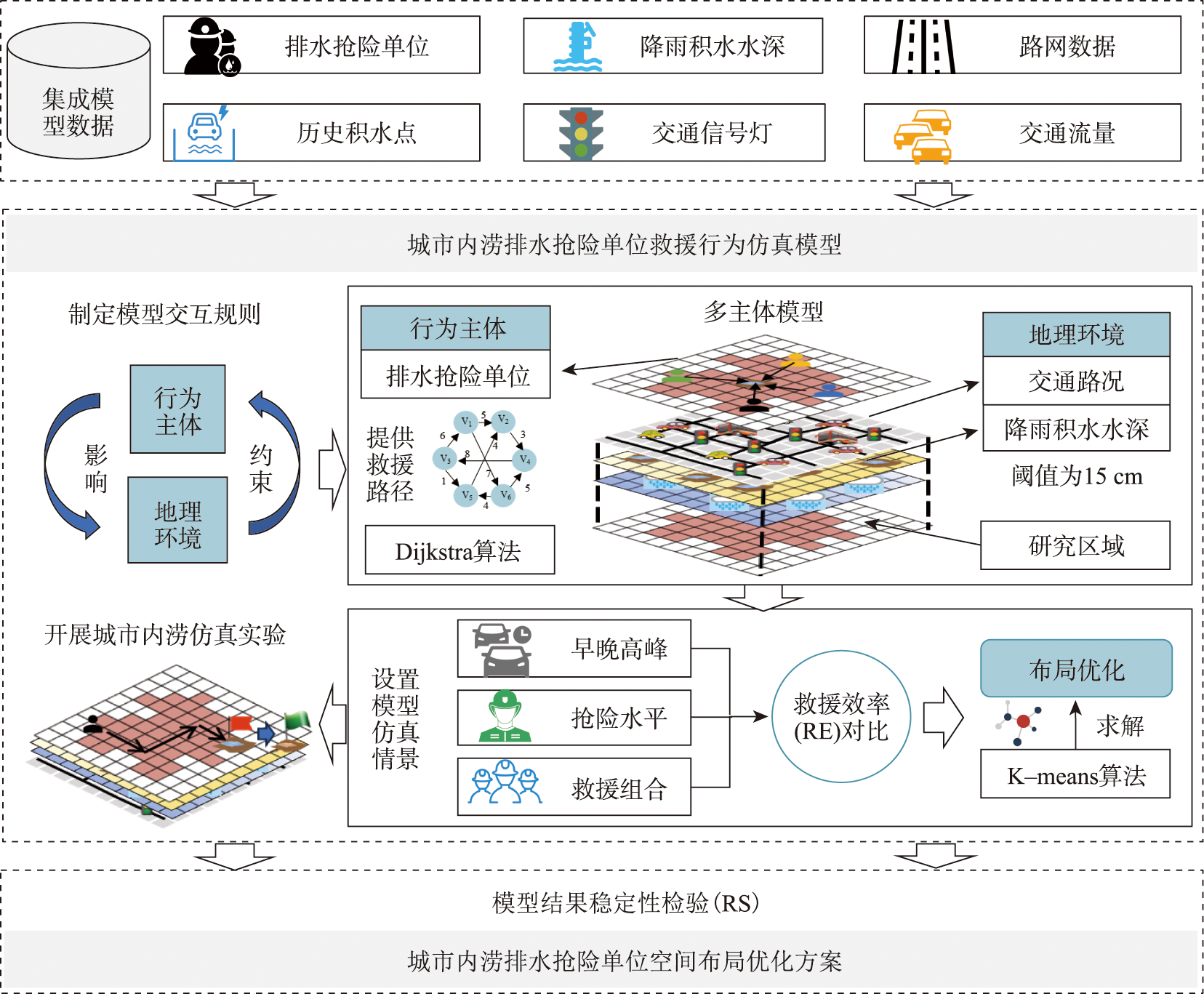

城市内涝排水抢险单位布局优化的仿真研究—以北京市百年极端降雨情景为例
|
张孟斐(1999—),男,河南商丘人,硕士生,主要从事城市洪涝灾害风险评估研究。E-mail: zhangmengfei8553@igsnrr.ac.cn |
Copy editor: 蒋树芳
收稿日期: 2024-01-29
修回日期: 2024-04-13
网络出版日期: 2024-06-25
基金资助
国家自然科学基金面上项目(41971233)
国家自然科学基金重大项目(72091511)
Optimization Simulation Study of Urban Flood Drainage Rescue Unit Layout: A Case Study of Beijing Under a Century-Extreme Rainfall Scenario
Received date: 2024-01-29
Revised date: 2024-04-13
Online published: 2024-06-25
Supported by
National Natural Science Foundation of China(41971233)
National Natural Science Foundation of China(72091511)
城市内涝灾害不断频发,不仅对城市基础设施和居民财产造成严重破坏,更损害了居民的生活质量和幸福感。排水抢险救援能力与城市内涝灾害强度的空间匹配性直接影响抢险救援效率。本研究以“信息集成-仿真建模-情景模拟-效率对比-方案优选”为思路,基于多智能主体构建了城市内涝排水抢险单位救援行为仿真模型,以北京市凉水河流域为例,结合内涝、交通与排水抢险单位分布信息开展了实证研究,模拟对比了不同情景下城市内涝排水抢险救援效率。结果表明,通过采用“全局分散,局部聚集”的排水抢险单位空间布局方案,抢险救援效率在早晚高峰、抢险水平和救援组合情景中分别提升了18.27%、18.24%和10.34%,模型结果稳定性达到了93.85%。在该布局方案下,排水抢险单位具有更均衡合理的任务分配,有效降低了高峰时期交通流量和信号灯对排水抢险救援效率的影响,同时排水抢险能力组合选择时更具优势。本研究提出的城市内涝排水抢险单位布局优化方案可提升抢险救援效率,降低灾害风险的社会影响,为城市内涝应急管理提供科学依据。

张孟斐 , 王丽晶 , 李永坤 , 郎立晨 , 郭纳良 , 吴锋 . 城市内涝排水抢险单位布局优化的仿真研究—以北京市百年极端降雨情景为例[J]. 地球信息科学学报, 2024 , 26(7) : 1688 -1701 . DOI: 10.12082/dqxxkx.2024.240066
The continuous and frequent urban flooding presents a formidable impediment to social and economic progress, imperiling community welfare. A critical aspect of urban flood emergency management involves enhancing the efficiency of drainage in rescue and relief operations. In this study, we combined diverse datasets encompassing the spatial distribution of urban rescue units, urban flooding occurrences, traffic dynamic flows, and traffic signal placements. We devised a multi-scenario simulation model for urban flood emergency response employing multi-agent based model guided by a "information integration - simulation modeling - emergency scenarios - efficiency comparison - optimization scheme". The model embedded Dijkstra algorithm to solve the optimal path for rescue and optimized the spatial layout of rescue points of rescue units with K-means algorithm. Through simulation experiments, we investigated the interaction between behavioral subjects and geographic environments, wherein rescue units navigate waterlogged areas, considering traffic constraints. The culmination of rescue and relief efforts is deemed achieved upon reducing water depth at all inundated points below the 15cm threshold. By formulating scenarios mirroring morning and evening peaks, diverse rescue levels, and rescue combination, we dissected the influence mechanisms of varied factors on rescue efficiency. Focused on the Liangshui River basin in Beijing, against the backdrop of a century-extreme rainfall event, our study scrutinized diverse emergency rescue scenarios, analyzed factors affecting rescue efficiency, and proffered optimization strategies for rescue unit layouts, to explore the path for the enhancement of rescue and relief efficiency. Our findings proposed optimized strategies for rescue unit deployment, advocating a spatial layout scheme emphasizing "global dispersion and local aggregation". Implementation of this scheme yielded substantial efficiency improvements by 18.27%, 18.24%, and 10.34% during morning and evening peak scenarios, varying rescue levels, and different rescue compositions, respectively. In addition, the efficiency of rescue during off-peak hours was significantly higher than that during peak hours. Moreover, we underscored the pivotal role of rescue personnel efficiency in dictating overall rescue efficacy, observing nonlinear, and accelerated efficiency declines with diminishing rescue personnel levels. Depending on the road conditions, there was uncertainty in the rescue efficiency of both joint rescues and individual stationary teams. Hence, within the realm of practical rescue operations, it is imperative to adeptly tailor rescue strategies to the nuanced dynamics of each scenario, encompassing variables such as rainfall intensity, traffic congestion, resource availability, and other pertinent factors. These adaptive measures ensure a nimble response that optimally addresses the evolving exigencies of urban flooding emergencies. Notably, our model attained a commendable stability rate of 93.85%. This study offers strategic recommendations for enhancing emergency rescue efficiency and assuaging the societal ramifications of urban flood risk, as well as scientific insights for urban flood emergency management.

| [1] |
|
| [2] |
|
| [3] |
|
| [4] |
张建云, 舒章康, 王鸿杰, 等. 郑州 “7·20” 暴雨洪涝几个水文问题的讨论[J]. 地理学报, 2023, 78(7):1618-1626.
[
|
| [5] |
刘业森, 刘媛媛, 李敏, 等. 降雨数据空间分辨率在城市流域洪峰变化分析中的影响[J]. 地球信息科学学报, 2022, 24(7):1326-1336.
[
|
| [6] |
|
| [7] |
|
| [8] |
|
| [9] |
|
| [10] |
|
| [11] |
孙钦珂, 周亮, 王宝. 气候变化背景下沿海特大城市复合洪水灾害空间模拟[J]. 地球信息科学学报, 2023, 25(12):2427-2438.
[
|
| [12] |
|
| [13] |
中华人民共和国中央人民政府. 国务院办公厅关于加强城市内涝治理的实施意见:国办发[2021]11号[A/OL]. (2021-04-08)[2024-03-21]. https://www.gov.cn/gongbao/content/2021/content_5605102.htm.
[ The State Council of the People's Republic of China. Implementation opinions of the General Office of the State Council on strengthening the control of urban waterlogging: Issued by General Office of the State Council of the People's Republic of China [2021] No. 11[A/OL]. (2021-04-08)[2024-03-21]. https://www.gov.cn/gongbao/content/2021/content_5605102.htm.]
|
| [14] |
刘文宋, 张仲英, 郑琳, 等. 基于改进HLT与深度学习的双时相PolSAR洪涝灾害监测新方法[J]. 地球信息科学学报, 2023, 25(8):1730-1745.
[
|
| [15] |
陈昆仑, 许红梅, 李志刚, 等. 快速城市化下的武汉城市暴雨渍水空间特征及发生机制[J]. 经济地理, 2020, 40(5):129-135,219.
[
|
| [16] |
|
| [17] |
|
| [18] |
|
| [19] |
|
| [20] |
|
| [21] |
|
| [22] |
李海宏, 吴吉东, 王强, 等. 基于机器学习方法的上海市暴雨内涝灾情预测模型研究[J]. 自然灾害学报, 2021, 30(1):191-200.
[
|
| [23] |
|
| [24] |
|
| [25] |
|
| [26] |
|
| [27] |
|
| [28] |
|
| [29] |
易嘉伟, 王楠, 千家乐, 等. 基于大数据的极端暴雨事件下城市道路交通及人群活动时空响应[J]. 地理学报, 2020, 75(3):497-508.
[
|
| [30] |
|
| [31] |
|
| [32] |
|
| [33] |
杨宇涵, 殷杰, 王丹丹, 等. 基于ABM的城市暴雨洪涝灾害应急疏散仿真研究——以河南郑州“7·20”特大暴雨洪涝灾害为例[J]. 中国科学:地球科学, 2023, 53(2):267-276.
[
|
| [34] |
|
| [35] |
|
| [36] |
|
| [37] |
中华人民共和国住房和城乡建设部. 城镇内涝防治技术规范: GB 51222—2017[S]. 北京: 中国计划出版社, 2017.
[ Ministry of Housing and Urban-Rural Development of the People's Republic of China. Technical code for urban flooding prevention and control: GB 51222—2017[S]. Beijing: China Planning Press, 2017.]
|
| [38] |
|
| [39] |
|
| [40] |
|
| [41] |
陈旻, 闾国年, 周成虎, 等. 面向新时代地理学特征研究的地理建模与模拟系统发展及构建思考[J]. 中国科学:地球科学, 2021, 51(10):1664-1680.
[
|
| [42] |
朱净萱, 戴强, 蔡俊逸, 等. 基于多智能体的城市洪涝灾害动态脆弱性计算模型构建[J]. 地球信息科学学报, 2021, 23(10):1787-1797.
[
|
| [43] |
|
| [44] |
陈悦峰, 董原生, 邓立群. 基于Agent仿真平台的比较研究[J]. 系统仿真学报, 2011, 23(S1):110-116.
[
|
| [45] |
赵刚, 史蓉, 庞博, 等. 快速城市化对产汇流影响的研究:以凉水河流域为例[J]. 水力发电学报, 2016, 35(5):55-64.
[
|
| [46] |
曾微波, 陈夏微, 童矿, 等. 红绿灯配时优化与仿真研究[J]. 武汉大学学报(信息科学版), 2022, 47(4):597-603.
[
|
| [47] |
房亚军, 李其军, 潘兴瑶, 等. 城市流域极端降雨条件下的产汇流规律——以北京市凉水河流域为例[J]. 陕西师范大学学报(自然科学版), 2018, 46(1):111-116.
[
|
| [48] |
李永坤, 薛联青, 邸苏闯, 等. 基于Infoworks ICM模型的典型海绵措施径流减控效果评估[J]. 河海大学学报(自然科学版), 2020, 48(5):398-405.
[
|
| [49] |
董炳艳, 张自强, 徐兰军, 等. 智能应急救援装备研究现状与发展趋势[J]. 机械工程学报, 2020, 56(11):1-25.
[
|
/
| 〈 |
|
〉 |